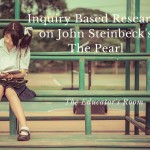 It is risky business, changing everything you teach and control in order to move towards a tech heavy classroom. I am one week into a 1:1 iPad rollout for all of the juniors and seniors at our rural high school. We are the last assigned group in our school wide transition to 1:1 iPads that began in August. While excitement still runs high I face reluctance and rebellion from students who have taken an anti disestablishment position. They are opposed to our school mandating use of an electronic device. Or they are ethically and philosophically opposed to Apple which has become a sudden phenomenon. I view this opposition as similar to refusing use of a required textbook. Argument and assertiveness probably will not win against student angst. Observations of the freshmen/ sophomore educators who pioneered implementation helped me reconsider the values inherent in how we teach. Here is what I learned two days into our rollout.
It is risky business, changing everything you teach and control in order to move towards a tech heavy classroom. I am one week into a 1:1 iPad rollout for all of the juniors and seniors at our rural high school. We are the last assigned group in our school wide transition to 1:1 iPads that began in August. While excitement still runs high I face reluctance and rebellion from students who have taken an anti disestablishment position. They are opposed to our school mandating use of an electronic device. Or they are ethically and philosophically opposed to Apple which has become a sudden phenomenon. I view this opposition as similar to refusing use of a required textbook. Argument and assertiveness probably will not win against student angst. Observations of the freshmen/ sophomore educators who pioneered implementation helped me reconsider the values inherent in how we teach. Here is what I learned two days into our rollout.
Get psyched about technology even if you are a Luddite. Instead of eyeing students suspiciously and brainstorming punishments for misuse of devices I consider the incentives instead. I decided to lead class with nonchalance.
Day 1- students enter class, routinely engage with vocabulary, followed by a 10 minute lecture, and textbook readings all without electronic devices. We examine an essay question on model rationales for legitimacy of leadership throughout history and analyze documents. Instead, I offered learning as a moveable feat. Students went on a scavenger hunt to find quotes hung on walls throughout the building. Elizabeth the Great hung in the library, Machiavelli near the principal’s office, Mao Zedong, near security. Students with devices could opt to take a picture and return to class. Students without could read them, and return to class to receive their paper handout. Students with iPads gleefully ran around taking pictures and returned to sit with peers who were already reading the paper copies. Both types of students were able to enjoy the content in the classroom without penalty. Equity was maintained even though Ipads allowed for instant highlighting and note-taking to email to partners upon request.
Do not rely on the wow factor of apps or iPads. I know how to split my typing screen and zoom between apps with a 5 finger swipe, because my tutor is my 8 year old daughter. Most students are digital natives, knowing more about technology than I will so I can not make the mistake of insisting that they use technology for a particular lesson. The need for control ruined projects for my pioneering colleagues and it has made me consider the skills students need to develop instead. It is two days before midterms and study skills need honing. I began the routine vocabulary lesson with their words printed on sticky notes, one set per group. Students groups were mixed between paper friendly and iPads. Each group leader introduced a word aloud while individuals attempted to illustrate the definition on a sketching app or a piece of paper. I demonstrated this on Notability with stick figure drawings. Students shared their illustrations and divergent interpretations with a focus on fun yet informative, corrective study. I posted all the vocabulary from the semester onto our Haiku platform page for student access. Students had the advantage of connecting to this immediately or still accessing paper copies in their classroom folders. We developed several versions of illustrative activities before moving onto other study strategies.
Choice is powerful. My colleagues were well intentioned when they assigned mandatory applications to a project based learning project. Had I pioneered I would have done the same thing. The educators were not experts but insisted students presentation rely solely on Explain Everything, a fantastic mashup for video, and notetaking. Problems arose and the problem solving took too long, students refused to complete the work, Luddites boasted that they knew this would fail and everyone looked foolish. I decided to focus not on the application but on the skill and the content that applications could provide. Starting with the Common Core:
CCSS.ELA-Literacy.RH.11-12.7 I intended to assess students on their ability to integrate and evaluate multiple sources of information presented in diverse formats and media by analyzing news sources. I ended my second day of classes by introducing students to a stack of newspaper sources we used to use and then to the benefits of an aggregator. I have been playing with Paper.li, Feedly, and Flipboard. Each app has a different aesthetic and pathway to the access of news. Ie- a magazine, pinboard or a frontpage feature appeal to different learners. Students choose which aggregator they would use with only one requirement, to include 2 suggested sources (BBC and Al Jazeera). Right away the benefits of having all news in a mobile device, instead of reading stacks of paper seems sensible. I will still keep one paper subscription and the Sunday New York Times on hand.
Routines are everything. Every day class ends with a formative assessment. Sometimes I put a poll or tally on a wall opposite the doorway, delivering this task when students cue restlessness. I plan to continue this practice alternating between paper activities and applications. For yesterday’s lesson I linked slaveryfootprint.org to a QR code and pinned that to a wall. Students scanned the code which brought them to the interactive lesson in current sweatshop labor practices worldwide. The site challenges the notion that consumption has a human price tag. Curiosity drew all to gather around a few iPads, conversing as survey choices were made. I kept an Upfront magazine article highlighting similar statistics handy but reactions to the interactive kept attention undivided. By the day’s end my last junior hold out signed out her iPad. I stayed nonchalant assuring that paper resources will continue to be a classroom resource.
Keep transforming. Sticking to classroom management systems and routines really do not have to change. What will change is the amount of control educators are used to. I am slow to transform so I rely on reading Twitter feeds from my favorite innovators, retweet eye-catching notions . Later, I revisit these on my homepage and read carefully. Vicky Davis reposted an article which addressed the very stage I am at.
@coolcatteacher: It Is Not About the Gadgets – Why Every Teacher Should Have to Integrate Tech Into Their Clas… http://t.co/zoklSnGppU via @pernilleripp
Some teachers assume that clicking on a SmartBoard or having students type their papers mean that they are “integrating” tech. This is one very limited usage of tech, in fact, it doesn’t really count as integration… True integration is when students have ideas and fearlessness to use technology to show their learning as a natural extension of the classroom. Not to type a paper.
If I insist on technology use only to meet a traditional outcome without including traditional practice as an option I will face student opposition. My role now is to present a framework for skill development, to suggest pathways but to be aware of collective experiences of these digital natives. Stay tuned as I continue to blend change and continuity, humility and success.




